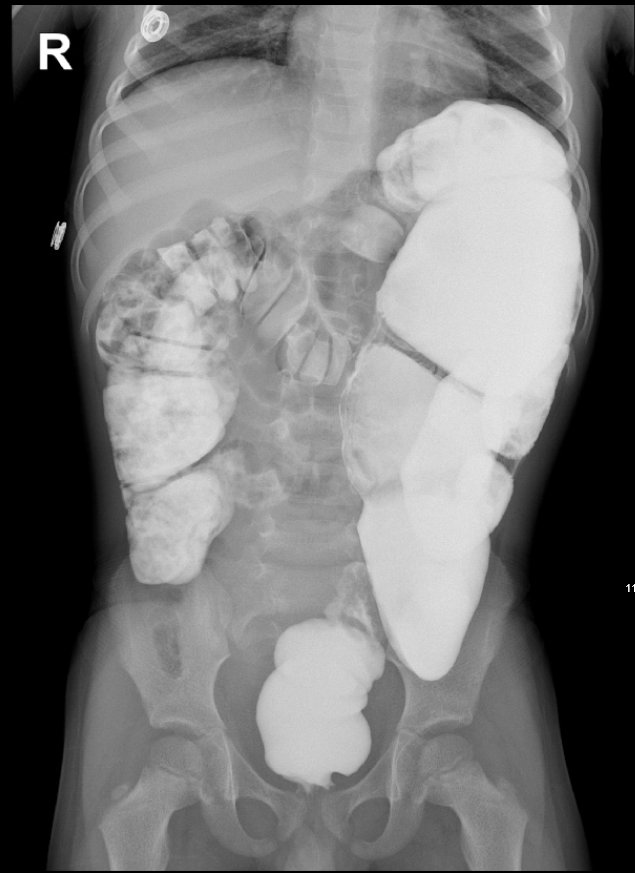Makindo Medical Notes"One small step for man, one large step for Makindo" |
|
|---|---|
| Download all this content in the Apps now Android App and Apple iPhone/Pad App | |
| MEDICAL DISCLAIMER: The contents are under continuing development and improvements and despite all efforts may contain errors of omission or fact. This is not to be used for the assessment, diagnosis, or management of patients. It should not be regarded as medical advice by healthcare workers or laypeople. It is for educational purposes only. Please adhere to your local protocols. Use the BNF for drug information. If you are unwell please seek urgent healthcare advice. If you do not accept this then please do not use the website. Makindo Ltd. |
Hirschsprung disease (congenital megacolon)
-
| About | Anaesthetics and Critical Care | Anatomy | Biochemistry | Cardiology | Clinical Cases | CompSci | Crib | Dermatology | Differentials | Drugs | ENT | Electrocardiogram | Embryology | Emergency Medicine | Endocrinology | Ethics | Foundation Doctors | Gastroenterology | General Information | General Practice | Genetics | Geriatric Medicine | Guidelines | Haematology | Hepatology | Immunology | Infectious Diseases | Infographic | Investigations | Lists | Microbiology | Miscellaneous | Nephrology | Neuroanatomy | Neurology | Nutrition | OSCE | Obstetrics Gynaecology | Oncology | Ophthalmology | Oral Medicine and Dentistry | Paediatrics | Palliative | Pathology | Pharmacology | Physiology | Procedures | Psychiatry | Radiology | Respiratory | Resuscitation | Rheumatology | Statistics and Research | Stroke | Surgery | Toxicology | Trauma and Orthopaedics | Twitter | Urology
🧠 Hirschsprung's disease is a congenital absence of enteric ganglion cells in the distal bowel → tonic contraction and functional obstruction. Early recognition and surgery prevent life-threatening enterocolitis and support normal growth. 👶
📖 About
- Hirschsprung's disease = aganglionosis of the distal bowel (myenteric + submucosal plexuses) → failure of relaxation 🚫.
- Also called congenital megacolon; incidence ≈ 1:5,000 live births.
🤝 Associations
- Family history 👪
- Genetic: Down syndrome (Trisomy 21), Waardenburg, MEN2 (RET), neurofibromatosis 🧬
- Other anomalies: VSD, renal anomalies 🫀🟦
🧪 Pathology
- Failed neural crest migration → absent parasympathetic ganglion cells distally.
- Aganglionic segment remains narrowed; proximal bowel becomes dilated and hypertrophic → megacolon 📈.
📍 Extent (Aetiology)
- ~70% rectosigmoid (short-segment) ✅
- ~20% entire colon (long-segment) ⚠️
- ~10% may extend into small intestine (total colonic/ileal) ⚠️
🩺 Clinical Features
- 🍼 Neonate: Delayed meconium >48 h, abdominal distension, bilious vomiting, poor feeding.
- 👶 Infant/child: Chronic constipation, abdominal bloating, FTT; explosive stool after DRE (“squirt sign”).
- 🔥 Hirschsprung-associated enterocolitis (HAEC): Fever, severe distension, foul diarrhoea, lethargy → emergency.
🔍 Differential Diagnoses
- Functional constipation
- Meconium ileus (CF) 🧪
- Imperforate anus / anorectal malformation
- Neonatal sepsis, intestinal atresia

🧪 Investigations (corrected)
- 🩻 Abdominal X-ray: Distended bowel loops; paucity of rectal gas.
- 🧪 Contrast enema: Transition zone (narrow distal aganglionic segment with proximal dilatation); avoid rectal exam just before study.
- 🎯 Anorectal manometry (infants): Absent recto-anal inhibitory reflex (RAIR) ➖.
- 🔬 Suction rectal biopsy (gold standard): Absent ganglion cells + hypertrophic nerve trunks; do ≥1.5 cm above dentate line.
- 🧬 Consider genetic testing (RET) and screen for associated anomalies; newborn CF screen if meconium ileus suspected.
🛠️ Management
- ⛑️ Stabilise: IV fluids, NG decompression, broad-spectrum antibiotics if HAEC, rectal saline washouts 💧.
- 🔪 Definitive surgery (pull-through):
- Swenson: Resection of aganglionic rectum with coloanal anastomosis.
- Soave: Endorectal mucosectomy; pull-through within muscular cuff.
- Duhamel: Side-to-side retrorectal anastomosis forming a neorectum.
- 🧷 Stoma: Considered in enterocolitis, severe dilatation, or staged procedures.
- 🏥 Post-op: Monitor for HAEC, anastomotic leak/stricture; bowel regimen, pelvic floor support.
📚 Case Example
👶 Case: Term male, day-3 of life, has not passed meconium. Marked distension, bilious vomiting, and a gush of foul stool after DRE (“squirt sign”). 🩻 AXR: Dilated bowel loops, paucity of rectal gas. 🧪 Contrast enema: Rectosigmoid transition zone. 🔬 Suction rectal biopsy: Absent ganglion cells with hypertrophic nerves → Hirschsprung’s confirmed. 🛠️ Management: IV fluids, rectal washouts, then laparoscopic-assisted Soave pull-through. ✅ Outcome: Good weight gain; stooling programme and surveillance for HAEC/stricture.
🔭 Prognosis
- 👍 Generally favourable after pull-through.
- ♻️ Some children have persistent constipation, soiling, or enterocolitis episodes—needs long-term follow-up.